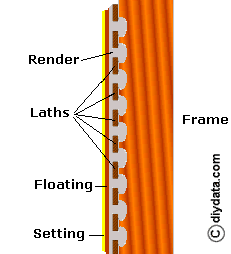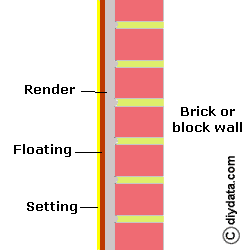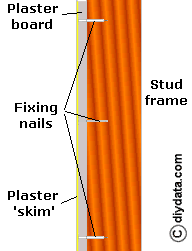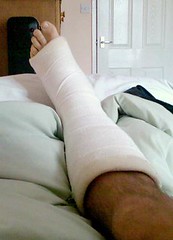Plaster is the most important and the oldest building material which is used in different kinds of home and residential construction projects. It can be made from clay, lime, or gypsum and its types vary concerning their compositions.

Image source: https://search.creativecommons.org/photos/1284ebda-53f7-4add-a1b5-3d42b590bcc8 by † David Gunter
What is plaster?
Plaster is a building material used for the protective and/or decorative coating of walls and ceilings and modeling and casting decorative elements. In English, “plaster” refers to a material used for the interiors of buildings, while “render” refers to external applications. Another imprecise term used for the material is stucco, also used for plasters that are processed to produce relief decoration, rather than flat surfaces.
The most common types of plaster mainly contain gypsum, lime, or cement, but they all work similarly. The plaster is produced as a dry powder and mixed with water to form a stiff but workable paste before being applied to the surface. The reaction with water releases heat by crystallization and the hydrated plaster hardens.
Plaster can be easily worked with metal tools or sandpaper and can be modeled, on-site or to make pre-formed sections in advance, which are placed with adhesive. Plaster is not a strong material; it is suitable for finishing, and when applied massively it may require a hidden supporting framework, usually in metal.

Image source: https://search.creativecommons.org/photos/bf5ee431-8105-4b6c-a0d6-f8861ec681a4 by Dominic’s pics
Techniques
Over the years, the practice of applying plaster to internal walls has changed quite a lot, the four basic forms found in post-Seventeenth-Century buildings are:
- Lath and plaster
From the early eighteenth until the Mid Twentieth century, internal, non-load-bearing walls were usually covered using lath and plaster techniques. The laths are the horizontal strips of wood (usually about 25mm by 6mm (1 by 1/4 inch) nailed to a vertical upright timber framework with about 6mm (1/4 inch) gap between each lath. The traditional method of coating lath and plaster walls was to apply three layers of lime putty mixture:
The first layer (aka the render layer) was about 8mm (3/8 inch) thick and was forced through the gaps between the laths to achieve a strong bond to the laths. The second layer (aka the floating coating) was about 6mm (1/4 inch) thick and was applied to achieve a smooth surface for the thin, final layer. The third and final layer (aka the setting layer) was about 3mm (1/8 inch) thick and was smoothed off to give a suitable finish for decorating.
Traditionally, the first and second layers were typically a 1:3 mixture of cleaning lime putty and sharp sand. Often, animal hair was also mixed in to help it bind together. The third layer was typically either lime putty on its own or a 3:1 lime putty to the fine sand mixture.
One disadvantage of using lime-based layers was that each layer could take up to three weeks to dry before the next layer could be applied; towards the end of the nineteenth century, the practice developed to add gypsum or cement to the mixtures to decrease the time delay between each layer. These mixes were typically 1:1:6 (gypsum/cement: lime putty: sharp sand) for the first two layers and equal parts gypsum and lime putty for the setting layer. The use of lath and plaster was largely replaced by the use of pre-manufactured plasterboard when that became available in the mid-twentieth century.

- Plaster
Where walls are brick, block, or stone, the typical finish is plaster. As with lath and plaster walls, three layers were applied – the render, the floating, and the setting layers.
The plaster mixes were traditionally the same as for lath and plaster – the render and floating layers 1:3 (lime putty: sharp sand) with animal hair often added – the setting layer either lime putty on its own or 3:1 (lime putty: fine sand). And again, towards the end of the 19th-century gypsum or cement was added to decrease the time between layers. These mixes were typically 1:1:6 (gypsum/cement: lime putty: sharp sand) for the first two layers and equal parts gypsum and lime putty for the setting layer.
By the mid 20th century, lime was largely replaced; the first two layers being straight sand and cement renders (1:6) (without animal hair being added) while the setting layer was gypsum plaster alone. Modern (21st century) practice tends to use premixed gypsum-based render (also referred to as ‘browning’) and finishing plasters.

- Plasterboard stud walling
With the development of sheet plasterboard in the mid-twentieth century, lath and plaster walls were largely overtaken by stud partitioning. Like lath and plaster, a basic timber framework was erected and, instead of attaching the laths, the sheets of plasterboard were simply cut to size and nailed in place. The joints between sheets were often just butted together and the whole surface skimmed with a setting plaster mixture – this, however, commonly lead to cracks in the walls along the edges of the plasterboard. Later the practice was introduced to apply ‘scrim’ (a fairly narrow (50mm (2 inches)) fine, flexible over-weave jute fabric or plastic tape) over the joints before the plaster skims were applied, this prevented the plaster skim from cracking along the joints.

- Dry lining
Dry-lining is a popular, quick alternative to rendered plaster on walls. Plasterboard is simply attached to masonry walls by a series of ‘dabs’ of plaster adhesive. The wall is covered by the dabs spaced horizontally and vertically about 400mm (16 inches) apart and the plasterboard is then applied and leveled. The joints between the plasterboard sheets are then sealed by covering with scrim and a thin application of a gypsum-based sealant. The surface of the plasterboard is not covered by plaster skin. When repairing a plaster wall, the repair should ideally be carried out using the same materials as the original wall. Modern gypsum plasters are a lot harder and more brittle than the traditional lime putty used in older constructions.

Types of plaster
There are different types of plasters that have their functionality and composition.

Image source: https://search.creativecommons.org/photos/1d21efc5-58f3-48d8-a420-34e84fdd4dd6 by shaire productions
- Bonding Plaster: This is a type of undercoat plaster, which means that it is applied directly on a wall as a base coat. It is also used for brickwork, blockwork, and breeze block. Having high adhesive power, it gets bound with most of the surfaces. Usually, a bag of 25 kg weight can be applied to an approximate area of 2.5 square meters with a depth of around 12mm. With a two-hour setting time, it can be applied on dense concrete blocks or engineering bricks.
- Sand-Faced Plaster: It is a layer of cement-sand mortar applied over brickwork. Also, it serves as a damp-proof coat over the masonry. This type of plaster is used to give a finishing touch to a surface let’s say to walls and ceilings. To some extent, it also serves as a sound and thermal insulation material. It adds a decorative touch to buildings and also provides a sustainable base for the paint colors. The first coat of the sand-surfaced cement plaster is applied in 1:4 cement mortar ratios with coarse sand. The plastering is left for seven days and then a second coat is applied in a 1:3 cement plaster ratio on the first coat. In the second coating, a sponge is applied on its wet surface and it should be well-watered for at least 15 days.
- Browning Plaster: The type of undercoat plaster is used on more absorbent surfaces. The backing coat plaster usually comes in grey or pink color. It is more appropriate to use this type of plaster on surfaces such as common bricks and building blocks or surfaces which have a stronger absorbing ability.
- Rough Cast Plaster: Roughcast plaster is composed of sand and gravel in a specific proportion and is applied over a freshly plastered surface. The base of plaster consists of two coats under a 12mm thick layer and a top layer with a thickness of 12mm in a cement mortar ratio of 1:3. Modern house designs in Pakistan use roughcast plaster for a more durable and decorative touch on the surface of walls and ceilings.
- One Coat Plaster: It is a mixture of binding plaster and multi finish and is called patching plaster. This is used to level the surface by filling up patching in one go and can be applied with a greater thickness as compared to undercoat plasters. Roughly, the thickness of the layer goes up to 50mm.
- Smooth-Cast Plaster: The finishing touch it gives resembles that of the sand-faced finish except for fine-grained sand and it is used at the place of coarse sand. There is no need for sponging to expose the sand surface. Usually, this kind of plaster is used to coat the internal walls.
- Board Finish: Board finish plaster is used on surfaces with low to medium absorbing ability. It is better to be applied to Plasterboard and Dry-Coat plaster.
- Multi-finish Plaster: This is a topcoat plaster, which is best for giving a high finishing touch to other surfaces.

Image source: https://search.creativecommons.org/photos/dd41e08b-31fa-4e06-9177-2e7fa3749161 by Red Moon Sanctuary
How plaster was used throughout history?
Plastering is one of the oldest building techniques. Evidence shows that primitive peoples plastered their reed or sapling shelters with mud, thus developing more durable structures and more effective shields against pests and weather. Over time, more durable and beautiful materials have replaced mud. Some of the earliest existing plasters are of comparable quality to those used in modern times. The Pyramids of Egypt contain plaster made at least 4,000 years ago which is still hard and durable. The main tools of the plasterer of that time were in design and purpose like those used today. For their best work, the Egyptians used a calcined gypsum plaster identical to the plaster of Paris.
Very early in Greek architecture (e.g., at Mycenae), fine white lime stucco plaster was used. Greek artisans had achieved high quality earlier than the 5th-century bc. Plaster was frequently used to cover the exteriors of temples, a technique is commonly known as stucco, in addition to covering the interiors, in some cases even when the building was made of marble.
The ornamental plaster ceilings of England during the reigns of Henry VIII, Elizabeth I, and James I still are admired. Earlier extant specimens of the plasterers’ skill in England are the pargeted and ornamented fronts of half-timbered houses.
Plaster as a medium of artistic expression waned by the 19th century when imitation and mechanical reproduction displaced this creative art. As a surface material for interior walls and ceilings and to a lesser degree for exterior walls, plaster remains in common use. It facilitates cleanliness and sanitation in buildings and is a retardant to the spread of fire.

Image source: https://search.creativecommons.org/photos/5b038545-ed2c-4b0f-b173-79e248e46b5f by archer10 (Dennis)

Image source: https://search.creativecommons.org/photos/40e94a2e-726a-4aed-aa59-c310e4f34a52 by Jwslubbock
Where can we find plaster today?
In architecture, plaster is also used to create complex details for use in room interiors. These can be geometric or naturalistic. Also often used to simulate wood or stone details found in more substantial buildings.
In art, lime plaster is the traditional matrix for fresco painting; the pigments are applied to a thin top layer of wet plaster and blend with it so that the painting is colored plaster. In the ancient world, plaster was used to create large figurative reliefs for walls, although only a few have survived.

Image source: https://search.creativecommons.org/photos/94510fbe-64a8-4d44-9c12-aee7e2082a34 by Beyond Forgetting
Nowadays this material is also used for suspended ceilings. In this case, the powder form is converted into a sheet form which is fixed to the base ceiling with the help of fasteners. It is made in various models containing various combinations of lights and colors.
Plaster forms have many other uses, such as orthopedic casts in medicine. Various types of models and molds are made with plaster.
Morticians and funeral home directors use plaster to recreate destroyed tissue, reconnect limbs to corpses, and fill wounds.

image source: https://search.creativecommons.org/photos/809367b2-cbe4-46cd-9bc9-0f51c45d976f by marktristan
Info sources:
https://en.wikipedia.org/wiki/Plaster
https://www.britannica.com/technology/plaster
http://www.diydata.com/general_building/plaster_walls/walls_plaster.php
http://www.slideshare.net/hamza359/basics-of-construction-learn-different-types-of-plasters-for-walls
